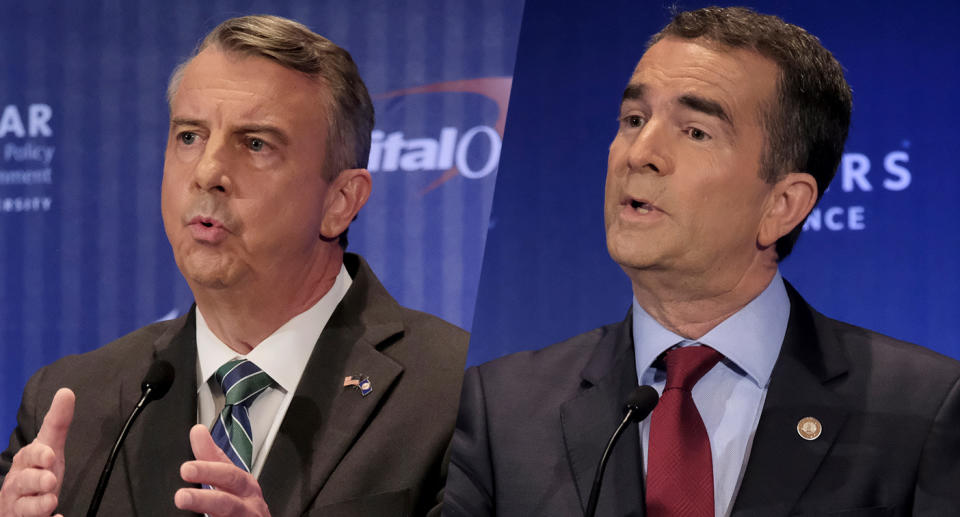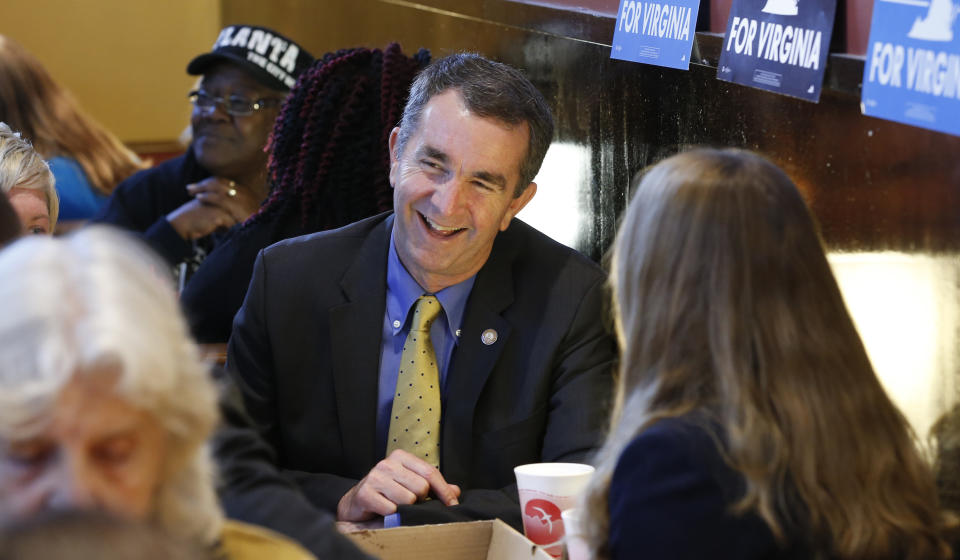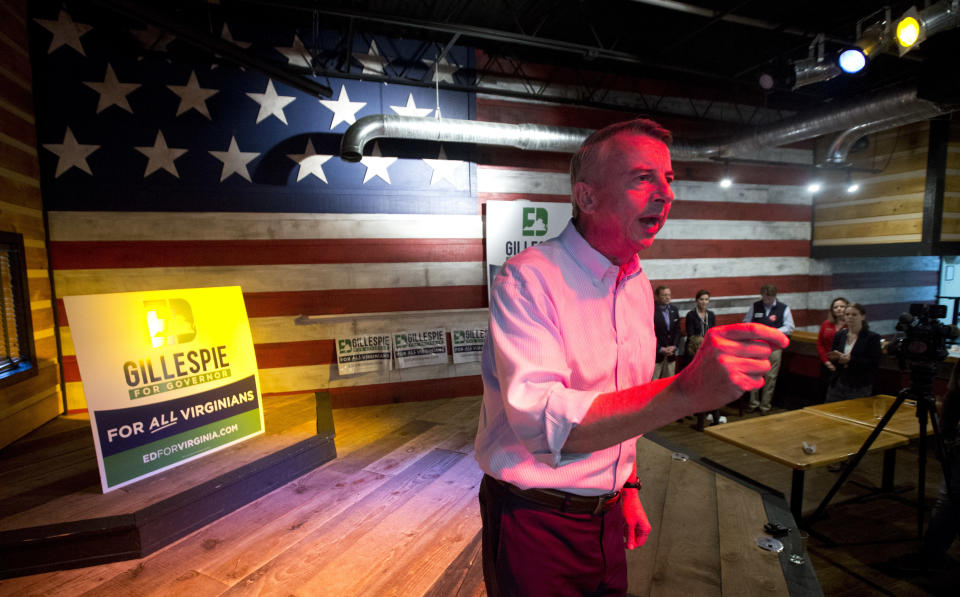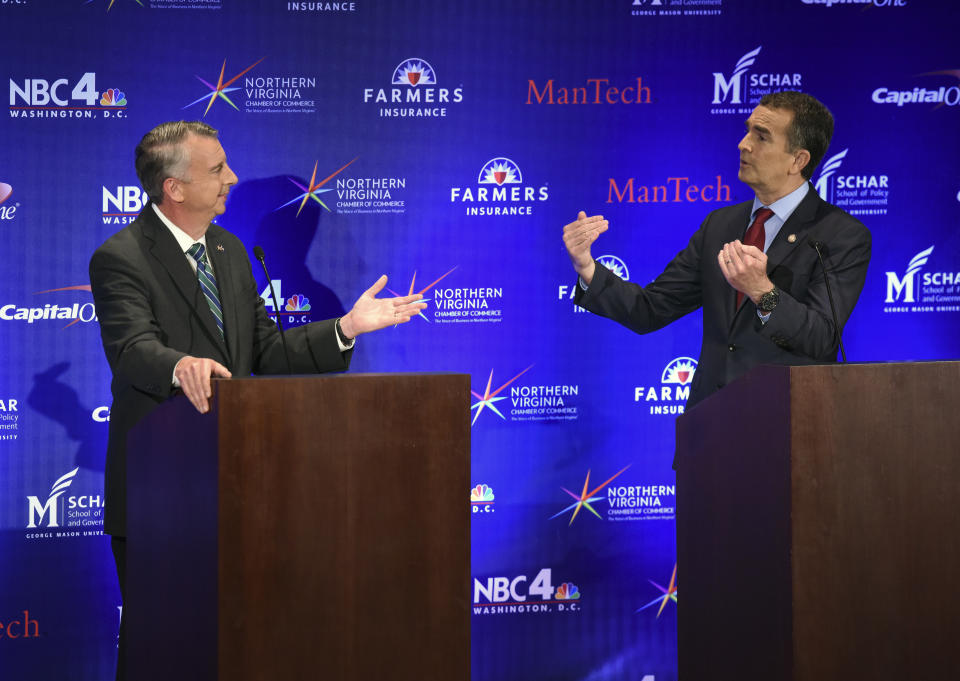In Virginia campaign, civility yields to racial appeals
Six weeks ago, the Virginia governor’s race was kind of boring, maybe in a good way.
Republican Ed Gillespie and Democrat Ralph Northam met Sept. 19 on a brightly lit stage in McLean, and for an hour politely discussed a laundry list of issues in front of a studio and television audience.
Headlines about the debate created a narrative that would hold for weeks. “Yes, Virginia: Politics Can Still Be Civil in the Trump Era,” NBC News said. “Few fireworks in gentlemanly Virginia gubernatorial debate,” wrote Politico.
“I’ve watched every VA GOV debate since 1981,” the University of Virginia’s Larry Sabato tweeted. “Never have [two] nominees been so respectful. They barely raised their voices.”

But even as the impression of a quiet contest took hold, the race was changing dramatically. The very next day, Gillespie’s campaign released a TV ad that transformed the race into a scorched-earth affair dominated by the Republican nominee’s appeals to voters on racially charged issues: immigration, Confederate monuments and NFL player protests.
Now, with Virginia voters set to choose a new governor Tuesday, Northam is limping to the finish line. He has struggled to rebuff Gillespie’s relentless attacks and has been unable to retake the initiative. He has even come under attack from other Democrats for moving closer to Gillespie’s positions on a few issues.
Democrats hope their advantage in registered voters, combined with anti-Trump sentiment, translates into victory. But they are worried that Northam’s low-key demeanor and conservative past — he voted for George W. Bush in 2000 and 2004 — has diminished enthusiasm on their side.

The results Tuesday night will have a significant impact on the course of American politics for the next year, as Virginia off-year elections often do. Campaign consultants in both parties will shape their strategies for next fall’s midterm elections based in part on what happens in the commonwealth.
If Gillespie wins, his campaign will be a template for Republican campaigns around the country. Voters will hear a national conversation about sanctuary cities, Latino gangs, Confederate monuments, NFL protests and whatever other hot-button issues get added to the mix. Democrats will be forced to develop effective counter-messaging.
If Northam wins, it will be viewed as a defeat for Trump and Trumpism, much more so than the results of Alabama’s Republican primary in late September. The candidate Trump endorsed, Luther Strange, lost in Alabama, but the Republican who won — Roy Moore — embodied Trumpism much more than his opponent.
The course of events since the debate in northern Virginia illustrates the difference between the two men. Gillespie and Northam are both known by friends and acquaintances as decent and intelligent men. But only one has a long history in the cutthroat world of electoral politics.
Gillespie has spent two decades at the highest levels of Republican national politics. He was involved in the Florida recount that decided the 2000 presidential election. He chaired the Republican National Committee. He was a senior adviser to the president in George W. Bush’s administration. He oversaw the GOP’s national effort to win over state legislatures and subsequently use those state house majorities to draw congressional districts in a way that helped Republicans dominate the House of Representatives. And he was in Mitt Romney’s inner circle during the 2012 presidential campaign. During the 2012 election, he complained to reporters about the increasingly cynical culture of political combat. In 2014, he ran for the U.S. Senate in Virginia and almost pulled off a huge upset of Sen. Mark Warner, a Democrat.
Northam is a country doctor with comparatively little political experience. He’s a pediatric neurologist who practices in Norfolk. He first was elected to the state Senate in 2007, and in 2009 came close to switching parties and becoming a Republican, according to reports at the time. He was elected lieutenant governor in 2013.
The men’s backgrounds help to explain why Gillespie has been willing to bloody Northam so mercilessly and relentlessly, and why the Democrats’ response has been so ineffective.
Gillespie positioned himself over the summer as the moderate establishment figure he’s always been. He talked regularly of being a governor for “all Virginians.” He told me in June that he had come to understand the term “Black Lives Matter” as a positive thing, after first being turned off.

“I remember the first time I heard ‘Black Lives Matter,’ and my reaction, I’m sure, was similar to that of many others, which was, ‘Well, of course they do. All lives matter,’” Gillespie said, seated in his Alexandria office. “As I thought about it and talked to people, it occurred to me that I never felt the need to say white lives matter. The fact that a significant portion of our fellow citizens feel the need to tell us that tells me something.”
“What does it tell you?” I asked him.
“It tells me that — well, I’ll just leave it at that,” Gillespie said, stopping himself from answering. He had just won the Republican primary — but only barely — over a far-right candidate, Corey Stewart, who campaigned as an immigration hardliner and who made Confederate monuments a rallying cry.
Gillespie also released an armada of serious policy papers on topics such as “sea level rise,” the “outdoor economy” and the “collective impact model as a framework to solve complicated problems.”
Gillespie’s paper on criminal justice reform said that there are “significant racial disparities in the criminal justice system, and socioeconomic factors that hold back some of our fellow Virginians, leading them to be statistically more likely to be involved with the justice system, and struggle upon re-entry. This cannot be ignored.”
Northam did not release detailed plans for health care or taxes or transportation. Gillespie did. All told, Gillespie’s policy papers amounted to 236 pages of detail. Northam put out only 80 pages.
But after Charlottesville, Gillespie’s candidacy began to take a harder turn right. He and Northam had articulated similar positions on Confederate statues in the weeks before a white supremacist rammed his car into a crowd of people protesting against neo-Nazis and KKK members on Aug. 12. The attack killed a 32-year old Charlottesville woman and injured 19 others.
After the attack, Northam jumped to more forcefully call for the removal of Confederate statues from public places.
Gillespie, however, took a more aggressive stance in favor of keeping the monuments. He also hired an organizer around that time from southwest Virginia who had been a top Donald Trump organizer in the state, who had said those who wanted to move Confederate statues to museums were Communists.
And on Aug. 30, Gillespie released his first ad hitting Northam over sanctuary cities, even though there are none in Virginia.
But it wasn’t until after the northern Virginia debate that Gillespie began running his more provocative ads. These commercials portrayed Latinos in a way Gillespie himself spoke out against just a few years ago. One showed a photo of heavily tattooed Latino gang members with the words “Kill, Rape, Control” (a motto of some MS-13 members).
Gillespie’s side argues that a Latino Victory Fund online video unfairly caricatured Gillespie supporters as racists. The LVF ad depicts an immigrant child’s nightmare in which he and his friends are fleeing a pickup truck with a Gillespie bumper sticker and a Confederate flag. “This ad tars everyday Virginians as bigots,” tweeted Garren Shipley, a spokesman for the Republican Party of Virginia.
Virginia Gov. Terry McAuliffe, a Democrat, said the LVF ad “wasn’t fair” and tried to distance Northam’s campaign from it. But Northam’s campaign gave money to the LVF for “media” on or around the day the ad was released.
The LVF ad was intended to alarm viewers, like Gillespie’s gang ad. Assessing the fairness of the ads is complicated.
MS-13 is not a new problem. It has had a significant presence in the area for two decades. But there’s some evidence of a resurgence in the gang’s strength, and there have been some grisly murders of late. However, most victims of the gang’s violence are other Latinos, who clearly aren’t the intended audience for Gillespie’s ads.
Latinos, meanwhile, were a favorite target of Trump during his campaign. He began his candidacy by characterizing Mexican immigrants as “rapists” and “killers,” and few of his promises aroused as much passionate enthusiasm from supporters as his promise to build a wall on the U.S.-Mexico border. Trump’s rise has emboldened white supremacist groups to march in broad daylight without masks.
In this context, immigrant and minority concerns about violence are obviously heightened. The LVD ad illustrates this fear and argues that Gillespie is encouraging bigotry and xenophobia with his advertising.
Virginia Democrats sent a mailer to voters in late October showing photos of Gillespie, Trump and torch-bearing white nationalists who marched in Charlottesville. “This is our chance to stand up to Trump, Gillespie, and hate,” the mailer said.
After Gillespie’s MS-13 ads, he released two TV ads about Confederate monuments, doubling down on his insistence that they “stay up.” There was no mention of the “thoughtful conversation about these sensitive issues” that Gillespie had talked about as recently as August.
And then this past week, Gillespie came down hard on NFL players who have taken a knee during the national anthem before their games to protest police brutality and racial injustice.
“You’d never take a knee … so take a stand on election day,” said a Gillespie mailer sent to voters. It was a long way from the comments Gillespie had made to me a few months earlier about how he understood why African-Americans had taken to saying “Black Lives Matter.” Most of the athletes who have participated in the NFL protests are black, and attitudes about the issue break down sharply along racial lines.
Polling in the final days of the campaign has shown a slight Gillespie surge. The Real Clear Politics average for all public polling still has Northam ahead by three points. Yet the conversation has been almost entirely about Gillespie, which has Trump allies feeling good about both the Virginia race and their own burgeoning brand of populist nationalism.
Steve Bannon, the former Trump adviser and head of Breitbart News, credited Gillespie’s hard right turn with saving his candidacy.
“It was the Trump-Stewart talking points that got Gillespie close and even maybe to victory,” said Bannon, referring to Gillespie’s hard-right primary opponent. “It was embracing Trump’s agenda.”

Read more from Yahoo News:



